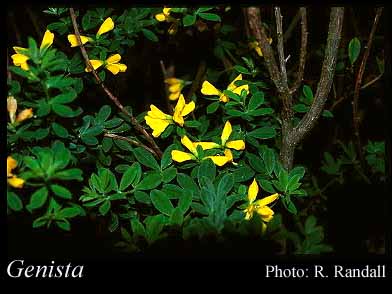- Reference
- Sp.Pl. [Linnaeus] 2:709 (1753)
- Name Status
- Current

Scientific Description
Family Papilionaceae. Genisteae.
Habit and leaf form. Shrubs; evergreen, or deciduous. ‘Normal’ plants, or switch-plants; the switch forms with the principal photosynthesizing function transferred to stems. Leaves well developed, or much reduced. Plants spiny, or unarmed. The spines axial, or foliar. Mesophytic, or xerophytic. Leaves minute to medium-sized; alternate; spiral; with blades, or bladeless; ‘herbaceous’, or leathery, or membranous, or modified into spines; not imbricate; petiolate to sessile; non-sheathing; simple, or compound; pulvinate to epulvinate (leaf bases prominent, persistent); when compound, unifoliolate, or ternate, or palmate. Leaves when trifoliolate, palmately trifoliolate. Leaflets 1–3; not stipellate; pulvinate, or epulvinate. Leaves with stipules (minute), or without stipules. Stipules intrapetiolar; free of one another; minute; caducous, or persistent. Leaves without a persistent basal meristem. Stem anatomy. Nodes tri-lacunar, or penta-lacunar. Secondary thickening developing from a conventional cambial ring.
Reproductive type, pollination. Fertile flowers hermaphrodite. Unisexual flowers absent. Plants hermaphrodite. Entomophilous.
Inflorescence and flower features. Flowers nearly always aggregated in ‘inflorescences’; not crowded at the stem bases; in racemes, or in heads, or in fascicles. Inflorescences simple, or compound. The terminal inflorescence unit cymose, or racemose. Inflorescences terminal (usually), or axillary. Flowers pedicellate; usually bracteate (the bracts small or leafy). Bracts persistent, or deciduous. Flowers usually bracteolate (the bracteoles small or leafy). Bracteoles persistent, or deciduous. Bracteoles not adnate to the receptacle. Flowers small to large; very irregular; zygomorphic. The floral asymmetry involving the perianth and involving the androecium. Flowers papilionaceous (imbricate-descending, with the posterior petal outside and forming a ‘standard’); basically 5 merous. Floral receptacle with neither androphore nor gynophore. Free hypanthium present, or absent. Perianth with distinct calyx and corolla; 10; 2 -whorled; isomerous. Calyx present; 5; 1 -whorled; gamosepalous; (five) lobed. Calyx lobes markedly shorter than the tube. Calyx imbricate, or valvate; exceeded by the corolla; bilabiate (the two posterior lobes almost free, the anterior three connate into a three-toothed lip); persistent; non-accrescent; with the median member anterior. Epicalyx absent. Corolla present; 5; 1 -whorled; appendiculate, or not appendiculate. Standard not appendaged. Corolla partially gamopetalous. 4 of the petals joined (the two ventral petals connivent to form the ‘keel’, and the claws of the wing and keel petals basally adnate to the androecial tube, but the wings not joined at their tips). The joined petals anterior (and lateral). The wings of the corolla adherent to the keel (via their claws, at the base of the staminal tube); not laterally spurred. Standard ‘normally’ developed (limb ovate to obovate); not sericeous. Keel straight or slightly incurved, or deflexed; not long-acuminate/beaked (obtuse); neither coiled nor spiralled; not bent and beaked. Corolla imbricate (descending); plain; white, or cream, or yellow, or purple, or violet, or blue; deciduous; non-accrescent. Petals clawed. Androecial members definite in number. Androecium 10. Androecial sequence determinable, or not determinable. Androecial members adnate (to claws of the lower petals); all equal, or markedly unequal; coherent (the filaments united basally into a usually closed tube); 1 - adelphous. The staminal tube adnate to the keel petals. Androecial members 1 -whorled. Androecium exclusively of fertile stamens. Stamens 10; distinctly dissimilar in shape (the anthers alternately long basifixed, short dorsifixed); diplostemonous; both opposite and alternating with the corolla members. Anthers separate from one another, or connivent; dimorphic (long-basifixed, short-dorsifixed); alternately dorsifixed and basifixed; alternately versatile and non-versatile; dehiscing via pores, or dehiscing via longitudinal slits; latrorse, or introrse; tetrasporangiate. Pollen shed as single grains. Gynoecium 1 carpelled. The pistil 1 celled. Carpels reduced in number relative to the perianth. Gynoecium monomerous; of one carpel; superior. Carpel stylate; apically stigmatic. Style apically (in-) curved, or hooked, or bent, or coiled (rarely). Style glabrous. Stigmatic tissue terminal to lateral. Carpel 2–50 ovuled (i.e. to ‘many’). Placentation marginal (along the ventral suture). Gynoecium median (the placenta posterior, on the ventral suture). Ovary sessile. Ovules pendulous to ascending; biseriate; arillate, or non-arillate; anatropous, or campylotropous to amphitropous, or hemianatropous.
Fruit and seed features. Fruit sessile; non-fleshy; hairy. The fruiting carpel dehiscent; a legume. Pods globose, or somewhat elongated, or much elongated (subglobose to linear); not triangular; not becoming inflated; more or less flat (rarely), or somewhat compressed to terete; regularly constricted between adjacent seeds, or irregularly constricted, or not constricted between the seeds; not transversely septate; wingless. Valves of the dehisced pod twisted, or not twisted. Fruit 1 celled; elastically dehiscent, or passively dehiscent. Dispersal unit the seed. Fruit 2–25 seeded. Seeds reniform or circular; endospermic, or non-endospermic; not mucous; small to large; arillate (the funicle expanded under the seed), or non-arillate. Cotyledons 2; if radicle flexed, accumbent. Embryo chlorophyllous; straight, or curved, or bent. Testa non-operculate. Micropyle zigzag, or not zigzag. Seedling. Germination phanerocotylar, or cryptocotylar.
Physiology, biochemistry. Nitrogen-fixing root nodules present. Aluminium accumulation not found. Photosynthetic pathway: C3.
Geography, cytology, number of species. Adventive. 2n=18, 22, 24, 26, 28, 30, 32, 36, 40, 42 44, 46, 48, 50, 52, 56, 72, 80, 96. A genus of about 80 species; 3 species in Western Australia.